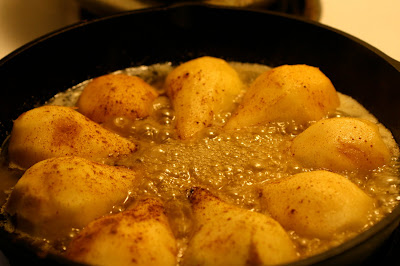Photo by Benji Shirley
We had some friends over for a pre-thanksgiving dinner (we had to stretch our stomachs in preparation for the real day after all). I was excited to bake the pie to complete the meal and had planned to make a salted chocolate ganache tart, the recipe for which I'd seen in Real Simple.
I had gone so far as to buy all the ingredients for the tart and was literally about to begin to prepare it when I found myself skimming the archives of Bon Appetit Magazine online. I stopped skimming and started reading when I saw the words "Crack pie." This pie recipe was created by the pastry chef from Momofuku's Milk Bar in NYC. The reviews were complete raves and let's just say that that apparently, this "Crack" pie was granted its name for a reason. Anyways, long story short, I just couldn't resist trying out the recipe.
The filling for the pie is essentially a chess pie (which means that it contains every bad-for-you ingredient imaginable...heavy cream, egg yolks, butter, sugar...) And the crust--I love this--is made from crumbled oatmeal cookie that you pre-bake.
The pie was amazing and rich. It has that wonderful buttery sweet flavor of a sugar cookie, while maintaining a delicious soft, almost custard-like texture in the filling. The oatmeal crust has an almost nutty butter flavor and provides a nice textural contrast for the filling.
Overall the recipe was simple, although I had a little bit of trouble getting the crust to smush together into the pie dish. It worked out eventually, although as you can see from the picture it didn't necessarily fill my deep pie dish.
I'm definitely going to keep this recipe filed away although it is so decadent that I will reserve it for the most special of occasions.
Crack Pie
Recipe from Momofuku, published by Bon Appetit. This recipe can also be found here, at the LA Times, but it's important to note that the LA times recipe makes 2 pies. The recipe I've listed below is based on the one published by Bon Appetit and makes one 9 inch pie.
Ingredients:
For the oat cookie crust:
-9 tablespoons of unsalted butter at room temperature
-5 1/2 tablespoons of brown sugar
-2 tablespoons of granulated sugar
-1 large egg
-3/4 plus 2 tablespoons of old-fashioned oats
-1/2 cup all purpose flour
-1/8 teaspoon baking powder
-1/8 teaspoon baking soda
-1/4 teaspoon of salt
For the filling:
-3/4 cup sugar
-1/2 cup packed brown sugar
-1 tablespoon of nonfat dry milk powder
-1/4 teaspoon salt
-1/2 cup unsalted butter, melted and cooled
-6 1/2 tablespoons heavy whipping cream
-4 large egg yolks
-1 teaspoon vanilla extract
-Powdered sugar for dusting pie before serving (I skipped this because I forgot!)
Preparation:
First prepare the oat cookie crust:
Preheat oven to 350°F. Line 13x9x2-inch metal baking pan with parchment paper or a sil pad. If not using sil pad, then oil the baking pan.
Combine 6 tablespoons butter, 4 tablespoons brown sugar, and 2 tablespoons sugar in medium bowl. Using electric mixer, beat mixture until light and fluffy, occasionally scraping down sides of bowl, about 2 minutes.
Add egg; beat until pale and fluffy.
Add oats, flour, baking powder, baking soda, and salt and beat until well blended.
Turn oat mixture out onto prepared baking pan; press out evenly to edges of pan.
Bake until light golden on top, 17 to 18 minutes. Transfer baking pan to rack and cool cookie completely.
In a food processor, pulse to crumble the oat cookie; add 3 tablespoons butter and 1 1/2 tablespoons brown sugar. Pulse further until butter and sugar are well distributed.
The mixture should be moist enough to stick together.
Transfer cookie crust mixture to 9-inch-diameter glass pie dish. Using fingers, press mixture evenly onto bottom and up sides of pie dish. Place pie dish with crust on rimmed baking sheet.
Now prepare the filling:
Position the rack in the center of your oven and preheat the oven to 350 F.
Whisk together both sugars, milk powder, and salt in medium bowl.
Add the melted butter and whisk until it is blended.
Add the cream, then egg yolks, and vanilla and whisk until well blended.
Pour filling into crust.
Bake pie 30 minutes. Reduce oven temperature to 325 F. Continue to bake pie until filling is brown in spots and set around edges but center still moves a bit when the dish is shaken, about 20 minutes.
Cool pie 2 hours in pie dish on rack. Chill uncovered overnight.




















































